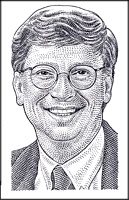
Together with Paul Allen, Bill Gates pioneered the development of Micro-Soft in 1975 (the hyphen was later removed). Like Allen, Gates had first been introduced to the computer age by a teletype machine installed at the Lakeside School in Seattle with funds raised by mothers through rummage sales. The Lakeside terminal was linked by phone to a remote mainframe. Instantly hooked, Gates, Allen, and other friends quickly developed a reputation for programming prowess and actually worked for Lakeside and a local company, Computer Center Corporation.Through their experiences, Gates and Allen recognized in the early 1970s that new computers would require increasingly sophisticated software to run. Micro-Soft was founded when the two friends devised a new version of the computer language BASIC to run the Altair 8800, developed by MITS, a company based in New Mexico. In 1980 Microsoft partnered with IBM to create an operating system for IBM's first personal computer. In order to meet a tight deadline, Microsoft purchased Q-DOS (Quick and Dirty Operating System) from Seattle Computer Products and revised it, transforming it into MS-DOS (Microsoft Disk Operating System), which quickly became the world's most popular operating system for personal computers. Having reached the distinction of attaining billionaire status by the age of thirty-one, Gates has continued with his success. A savvy businessman, in addition to being well-versed in the development of new programming technology, Gates has long understood the value of running new computers, rather than building them. As he explained in 1994, "When you have the microprocessor doubling in power every two years, in a sense you can think of the computer as almost free. So you ask, 'Why be in the business of making something that's almost free? What is the scarce resource? What is it that limits being able to get value out of that infinite computer power?' 'Software.'"

